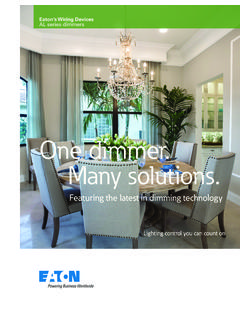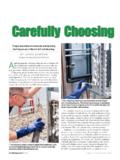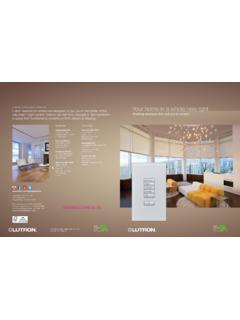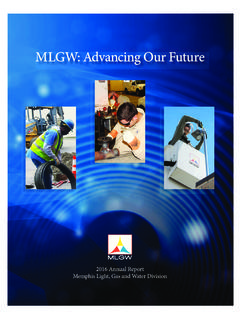Transcription of Energy Efficient Lighting by Using LED Vs. T5 Technology
1 IOSR Journal of Electrical and Electronics Engineering (IOSR-JEEE) e-ISSN: 2278-1676,p-ISSN: 2320-3331, Volume 11, Issue 2 Ver. I (Mar. Apr. 2016), PP 47-48 DOI: 47 | Page Energy Efficient Lighting by Using LED Vs. T5 Technology Avijit Karmakar1, Snehashis Das2, Ayan Ghosh3 1,2,3 (Department Of Electrical Engineering, Technique Polytechnic Institute/WBSCTVESD, India) Abstract: Energy is one of the most fundamental parts of our world. Energy has come to be known as a strategic commodity and any uncertainty about its supply can threaten the functioning of the entire economy, particularly in developing economies. India s substantial and sustained economic growth is placing enormous demand on its Energy resources. The Energy management can be done by two ways. One is the use of new Technology for generating power and another is the use of Energy saving electrical products/equipments/instruments.
2 Electrical Energy is very precious and its need to be utilized properly, so Energy management plays an important role now a day especially in illumination engineering. In illumination engineering the main thrust is on Energy Efficient and cost effective features of the system, in India since 17 20% of the Energy goes for Lighting . Keywords: Energy efficiency, fluorescent tube, LED tube, CRI, I. Introduction LED Lighting is one possible wave of the future. As more companies retrofit their buildings to reduce Energy consumption, many may turn to LED Lighting solutions in their efforts to reduce Energy costs. While promising, current LED Technology may not be the best solution to fix your company s Energy inefficiencies. This paper compares LED and T5 Lighting technologies and illustrates the advantages and disadvantages of both Energy Efficient Lighting solutions. Actually we consider the main technical and environmental features of both types of lamps.
3 Regarding technical features of both types of lamps, at first we collect the data of different manufacturer s product and finally select the lamps as per availability in the market. Another consideration for choosing the lamp is CCT , that is equal for both types of lamps. 6500K is called the Day light value. II. The Greener Option LED is the greenest option available in all forms of Lighting . And that is because: It does not contain any mercury, which is harmful for environment unlike the fluorescent bulbs and lights. It lasts much longer (about 10-20 years) and thus their disposal is less of a concern. Fluorescent lights on the other hand contain mercury that is harmful for environment and their disposal is a concern. And this is a problem with both CFLs and fluorescent tube lights. III. LIFE Of The LIGHT Most fluorescent bulbs/tubes may not last more than 3-4 years (10000-15000 hrs of usage).
4 But LEDs last much longer (up to 25000-50000 hrs of usage). And as with all light bulbs, the life of the luminaries will depend on the quality. All lights emit heat and the better the heat sink, the better the life. A good fluorescent light may last up to 4 years but can also die before that based on the environment and the quality of heat sink. Similarly life of LED will depend on the quality of its heat sink and the internal circuitry. Just like cheap CFLs, cheaper LEDs may not last long and thus buying a branded LED can be a better approach. T-8 LED Tube IV. Lumens Or Brightness Of The Light LEDs are always marketed as Lighting options that give more brightness per watt of electricity. The claim is true if LEDs are used for spotlighting. LEDs are unidirectional source of light and thus they are excellent for spot Lighting . LED luminaire that are available for general-purpose Lighting have inbuilt reflectors that spread the light in all directions.
5 And the use of reflectors causes decrease in brightness per watt. This results in their efficiency come down to as low as that of fluorescent lights. So if you compare a T5 tube light with a LED light that gives light at 120 degrees angle (we mention angle because LEDs are unidirectional and they are marked for an angle based on the reflectors used), the amount of light that LED tube will give per watt Energy Efficient Lighting By Using LED Vs. T5 Technology DOI: 48 | Page will be similar to that of T5 tube light. Thus from an Energy saving perspective, both T5 and LED tube lights will have the same impact. The LED will provide Energy saving benefit if it is used for spot Lighting . V. Technical Comparison Between T-5 And Led Tube Lights CRI Index Another factor to consider before replacing your current light fixtures with more Energy Efficient light fixtures is the Color Rendering Index (CRI).
6 The CRI measures a bulb s ability to reveal small shade variations between colors on a scale ranging from zero to one hundred. The Measurement Science and Technology , reports that T-5 fluorescent lights have significantly higher CRI than LEDs. T-5 lights obtained a CRI rating of 85; while the single LED received a rating lower than T-5. But nowadays several companies have developed high power LEDs which are extremely bright and can be used where high light output is required like street Lighting and task Lighting . These are referred as Lighting class study suggests that T-5 bulbs may produce a higher quality light than LED bulbs. Other studies have shown that higher quality light yields numerous benefits, including increased worker productivity. It s commonly known that LED luminaires are expensive. They cost at least 3-4 times more than T5 fluorescent lights. However their life is also much longer as compared to fluorescent lights.
7 Type Costs Payback Life Efficiency T-8 LED Tube light Rs 1600-2000 3-4 years 10-15 years About 110-120 lumens per watt T-5 Fluorescent Tube light Rs 500 6 months to 1 year 3-4 years 110 lumens per watt Regular Fluorescent T-8 Tube light Rs 100 3-4 years 60-80 lumens per watt (lower for one with electromagnetic ballast) The table above is based on costs of various types of tube lights. The LEDs are expensive but they last long and thus provide Energy saving for longer periods. Their payback period (or cost recovery due to savings in electricity bills) is slightly longer just because of the upfront capital cost. VI. Conclusion LEDs have proven to be extremely effective due to their long lifespan and increased efficiency. Many companies have successfully purchased LED exit signs and substituted other hard-to replace Lighting fixtures with LED bulbs. However, T5 fluorescent bulbs have performed significantly better in multiple studies that are critical to commercial and residential usage.
8 If we are looking at retrofitting our building from old T12 or T8 Lighting fixtures to a more Efficient Technology , it is important to consider essential factors such as heat dissipation, the CRI rating, efficacy, overall cost, lifespan and lumen outputs of bulbs. In case of lumen output comparison of both types of lamps it is found that same lumen output LED tube as compare with T-5 is very much costly. So before make the bound to Energy efficiency, build firm a new Lighting Technology is the best in its field. Reference [1]. "LED light sources: a survey of." Measurement Science and Technology (2008): 115. Web. 28 Dec 2009. [2]. GE Ecolux Watt-Miser Starcoat T5." GE Lighting . Web. 7 Jan 2010. [3]. Applied Illumination Engineering Second Edition, By Jack L. Lindsey [4]. Philips Lighting Catalogue 2014/15 [5]. Philips Lighting Catalogue, Lamp specification guide, 2013 Wattage Lumen CRI CCT Average life time (hrs) T-5 Fluorescent Tube light 28 2700 85 6500 24000 T-8 LED Tube light 20 2100 80 6500 40000

















